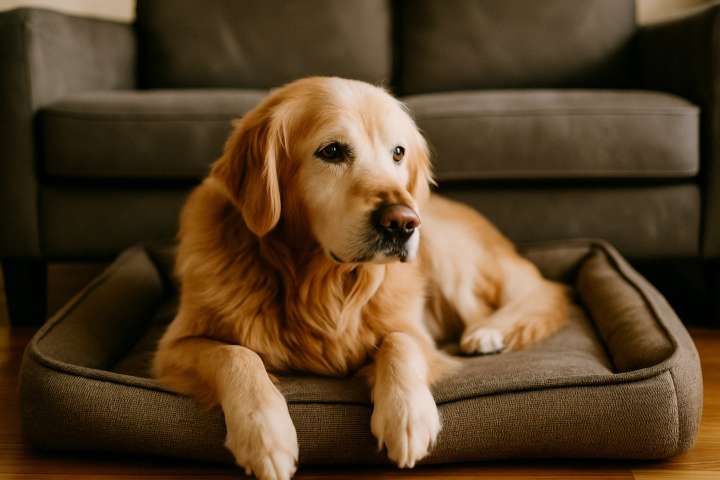Senior dog health is all about adapting your care to meet your aging pet’s changing needs. As dogs age, their needs change—and so should your approach to their care. While growing older is natural, senior dogs require extra attention to ensure they remain comfortable, happy, and healthy.
In this guide, we’ll walk you through what to expect during your dog’s senior years, the most common health changes, and how to prepare with proactive care and love.
When Is a Dog Considered a Senior?
The answer depends on breed and size:
- Small breeds (under 25 lbs): 10–12 years
- Medium breeds (25–50 lbs): 8–10 years
- Large breeds (50–90 lbs): 6–8 years
- Giant breeds (90+ lbs): 5–7 years
Lifespan varies widely, but most dogs enter their senior phase around 7–10 years old.
Common Changes in Senior Dogs
As your dog ages, you may notice changes in:
Mobility
- Stiff joints, slower walking, hesitation to jump
- Possible signs of arthritis or hip dysplasia
Cognitive Function
- Confusion, restlessness at night, or forgetting routines
- Possible signs of Canine Cognitive Dysfunction (dog dementia)
Dental Health
- Bad breath, loose teeth, or difficulty chewing
- Gum disease becomes more common
Vision & Hearing
- Cloudy eyes or bumping into objects
- Slower response to commands or sounds
Weight & Appetite
- Weight gain due to slower metabolism
- Weight loss from dental pain or illness
- Decreased or picky appetite
Urination & Hydration
- More frequent urination or accidents
- Increased thirst (could indicate kidney or endocrine issues)
How to Support Your Senior Dog’s Health
- Schedule Regular Vet Visits
- Switch to twice-yearly checkups
- Run bloodwork and urine tests to detect early signs of kidney, liver, thyroid, or other chronic conditions
- Discuss senior-specific vaccines and medications
2. Adjust Their Diet
- Choose a senior formula dog food with:
- Fewer calories (to prevent weight gain)
- High-quality protein (to preserve muscle)
- Added Omega-3s, glucosamine, and antioxidants
- Increase water intake through:
- Wet food
- Bone broth
- Water fountains
Tip: Ask your vet about supplements like fish oil, turmeric, or probiotics for aging support.
3. Support Mobility and Comfort
- Provide orthopedic beds or memory foam mattresses
- Use ramps or steps for furniture or car access
- Keep nails trimmed to avoid slips
- Consider joint supplements with glucosamine and chondroitin
Gentle, daily exercise (like short walks) helps maintain mobility without strain.
4. Maintain Dental Care
- Brush teeth regularly with dog-safe toothpaste
- Use dental chews or water additives
- Schedule professional dental cleanings as needed
5. Watch for Cognitive Changes
- Keep a consistent daily routine
- Avoid major environmental changes
- Use puzzle toys, scent games, and new commands to keep the brain engaged
- Ask your vet about supplements for cognitive support (e.g. SAMe, fish oil, vitamin E)
6. Grooming & Skin Care
- Senior dogs often have drier skin or thinner coats
- Brush regularly to stimulate circulation
- Use hypoallergenic or moisturizing shampoos
- Check for lumps, skin infections, or parasites
7. Emotional Wellness & Bonding
- Spend quiet time together daily
- Offer gentle massage and soothing physical contact
- Be patient—older dogs may become anxious, clingy, or more vocal
They may not run like they used to, but your presence remains their greatest comfort.
Checklist: How to Prepare for Your Dog’s Senior Years
- Transition to senior dog food
- Schedule biannual vet visits
- Begin daily joint supplements
- Create a cozy, accessible home environment
- Track water intake, appetite, and behavior
- Monitor mobility and grooming needs
- Keep a record of any new symptoms
Conclusion
Final Thoughts on Senior Dog Health
Aging is a journey—not an illness. With small adjustments, you can help your senior dog age gracefully and comfortably. The key is proactive care, observation, and compassion. After years of loyalty, they deserve nothing less.
Want a printable Senior Dog Health Checklist or care planner? Visit our Senior Dog Resource Hub for free tools to track changes, routines, and vet visits.

